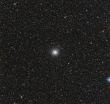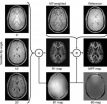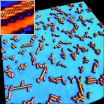(Press-News.org) The Milky Way galaxy is orbited by more than 150 globular star clusters, which are balls of hundreds of thousands of old stars dating back to the formation of the galaxy. One of these, along with several others in the constellation of Sagittarius (The Archer), was found in the late eighteenth century by the French comet hunter Charles Messier and given the designation Messier 54.
For more than two hundred years after its discovery Messier 54 was thought to be similar to the other Milky Way globulars. But in 1994 it was discovered that it was actually associated with a separate galaxy — the Sagittarius Dwarf Galaxy. It was found to be at a distance of around 90 000 light-years — more than three times as far from Earth as the galactic centre.
Astronomers have now observed Messier 54 using the VLT as a test case to try to solve one of the mysteries of modern astronomy — the lithium problem.
Most of the light chemical element lithium now present in the Universe was produced during the Big Bang, along with hydrogen and helium, but in much smaller quantities. Astronomers can calculate quite accurately how much lithium they expect to find in the early Universe, and from this work out how much they should see in old stars. But the numbers don't match — there is about three times less lithium in stars than expected. This mystery remains, despite several decades of work [1].
Up to now it has only been possible to measure lithium in stars in the Milky Way. But now a team of astronomers led by Alessio Mucciarelli (University of Bologna, Italy) has used the VLT to measure how much lithium there is in a selection of stars in Messier 54. They find that the levels are close to those in the Milky Way. So, whatever it is that got rid of the lithium seems not to be specific to the Milky Way.
This new image of the cluster was created from data taken with the VLT Survey Telescope (VST) at the Paranal Observatory. As well as showing the cluster itself it reveals the extraordinarily dense forest of much closer Milky Way stars that lie in the foreground.
INFORMATION:
Notes
[1] There are several possible proposed solutions to the riddle. The first is that the calculations of the amounts of lithium produced in the Big Bang are wrong — but very recent tests suggest that this is not the case. The second is that the lithium was somehow destroyed in the earliest stars, before the formation of the Milky Way. The third is that some process in the stars has gradually destroyed lithium during their lives.
More information
This research was presented in a paper, "The cosmological Lithium problem outside the Galaxy: the Sagittarius globular cluster M54", by A. Mucciarelli et al., to appear in Monthly Notices of the Royal Astronomical Society (Oxford University Press).
The team is composed of: A. Mucciarelli (University of Bologna, Italy), M. Salaris (Liverpool John Moores University, Liverpool, UK), P. Bonifacio (Observatoire de Paris, France), L. Monaco (ESO, Santiago, Chile) and S. Villanova (Universidad de Concepcion, Concepcion, Chile).
ESO is the foremost intergovernmental astronomy organisation in Europe and the world's most productive ground-based astronomical observatory by far. It is supported by 15 countries: Austria, Belgium, Brazil, the Czech Republic, Denmark, France, Finland, Germany, Italy, the Netherlands, Portugal, Spain, Sweden, Switzerland and the United Kingdom. ESO carries out an ambitious programme focused on the design, construction and operation of powerful ground-based observing facilities enabling astronomers to make important scientific discoveries. ESO also plays a leading role in promoting and organising cooperation in astronomical research. ESO operates three unique world-class observing sites in Chile: La Silla, Paranal and Chajnantor. At Paranal, ESO operates the Very Large Telescope, the world's most advanced visible-light astronomical observatory and two survey telescopes. VISTA works in the infrared and is the world's largest survey telescope and the VLT Survey Telescope is the largest telescope designed to exclusively survey the skies in visible light. ESO is the European partner of a revolutionary astronomical telescope ALMA, the largest astronomical project in existence. ESO is currently planning the 39-metre European Extremely Large optical/near-infrared Telescope, the E-ELT, which will become "the world's biggest eye on the sky".
Links
Research paper: http://www.eso.org/public/archives/releases/sciencepapers/eso1428/eso1428a.pdf
Photos of the VST: http://www.eso.org/public/images/archive/category/surveytelescopes/
Contacts
Alessio Mucciarelli
University of Bologna
Bologna, Italy
Tel: +39 051 20 95705
Email: alessio.mucciarelli2@unibo.it
Lars Lindberg Christensen
Head of ESO ePOD
Garching bei München, Germany
Tel: +49 89 3200 6761
Cell: +49 173 3872 621
Email: lars@eso.org
This star cluster is not what it seems
VLT observations of Messier 54 show the lithium problem also applies outside our galaxy
2014-09-10
ELSE PRESS RELEASES FROM THIS DATE:
New method to detect prize particle for future quantum computing
2014-09-10
Quantum computing relies on the laws of quantum mechanics to process vast amounts of information and calculations simultaneously, with far more power than current computers. However, development of quantum computers has been limited as researchers have struggled to find a reliable way to increase the power of these systems, a power measured in Q-Bits.
Previous attempts to find the elusive Majorana particle have been very promising but have not yet provided definitive and conclusive evidence of its existence.
Now, researchers from the University of Surrey and the Ben-Gurion ...
Combining antibodies, iron nanoparticles and magnets steers stem cells to injured organs
2014-09-10
LOS ANGELES – Researchers at the Cedars-Sinai Heart Institute infused antibody-studded iron nanoparticles into the bloodstream to treat heart attack damage. The combined nanoparticle enabled precise localization of the body's own stem cells to the injured heart muscle.
The study, which focused on laboratory rats, was published today in the online peer reviewed journal Nature Communications. The study addresses a central challenge in stem cell therapeutics: how to achieve targeted interactions between stem cells and injured cells.
Although stem cells can be a potent ...
PPPL scientists take key step toward solving a major astrophysical mystery
2014-09-10
Magnetic reconnection can trigger geomagnetic storms that disrupt cell phone service, damage satellites and black out power grids. But how reconnection, in which the magnetic field lines in plasma snap apart and violently reconnect, transforms magnetic energy into explosive particle energy remains a major unsolved problem in plasma astrophysics. Magnetic field lines represent the direction, and indicate the shape, of magnetic fields.
Now scientists at the U.S. Department of Energy's (DOE) Princeton Plasma Physics Laboratory (PPPL) have taken a key step toward a solution, ...
MRI shows gray matter myelin loss strongly related to MS disability
2014-09-10
OAK BROOK, Ill. – People with multiple sclerosis (MS) lose myelin in the gray matter of their brains and the loss is closely correlated with the severity of the disease, according to a new magnetic resonance imaging (MRI) study. Researchers said the findings could have important applications in clinical trials and treatment monitoring. The study appears online in the journal Radiology.
Loss of myelin, the fatty protective sheath around nerve fibers, is a characteristic of MS, an inflammatory disease of the central nervous system that can lead to a variety of serious neurological ...
Parents' separation found to boost children's behavior problems, but only in high-income families
2014-09-10
Before they reach young adulthood, most children in the United States will experience their parents separating, divorcing, finding another partner, or getting remarried.
Research tells us that children have more behavior problems (such as aggression and defiance) when families change structure. Now a new study has found that behavior problems in children increased in families in which parents separated only in higher-income families, and that children's age also played a part in their likelihood of having behavior problems.
The study, by researchers at Georgetown University ...
Mothers' responses to babies' crying: Benefiting from and getting over childhood experiences
2014-09-10
Research has told us that infants whose mothers respond quickly, consistently, and warmly when they cry have healthier emotional development than infants whose mothers are less sensitive to their cries. A new study has found that mothers whose childhood experiences with caregivers was positive and those who have come to terms with negative experiences are more infant-oriented when they see videos of babies crying and respond more sensitively to their own babies' cries.
The study, by researchers at the University of North Carolina at Greensboro, with input from colleagues ...
When talking about body size, African-American women and doctors may be speaking different languages
2014-09-10
PHILADELPHIA, PA, September 10, 2014 – African American women and their female children have the highest obesity prevalence of any demographic group and are more likely to underestimate their body weight than white women. Yet, according to new research from Rush University Medical Center, cultural norms for body size may prevent awareness among many African American women about the potential health benefits they and others in their cultural group might achieve through weight loss.
Led by Elizabeth Lynch, PhD, this research recruited African American women in a low-income ...
Smartphones may aid in dietary self-monitoring
2014-09-10
PHILADELPHIA, PA, September 10, 2014 – Smartphones have seen wide adoption among Americans in recent years because of their ease of use and adaptability. With that in mind, researchers from Arizona State University examined how smartphone use affected weight loss goals and determined that smartphones may offer users an advantage over traditional methods when tracking diet data.
Roughly 83% of Americans now own a mobile phone and 45% own smartphones with Internet access. For this study, researchers recruited healthy, weight-stable adults and semirandomly divided them ...
Molecular self-assembly controls graphene-edge configuration
2014-09-10
Sendai, Japan – A research team headed by Prof. Patrick Han and Prof. Taro Hitosugi at the Advanced Institute of Materials Research (AIMR), Tohoku University discovered a new bottom-up fabrication method that produces defect-free graphene nanoribbons (GNRs) with periodic zigzag-edge regions. This method, which controls GNR growth direction and length distribution, is a stepping stone towards future graphene-device fabrication by self-assembly.
Graphene, with its low dimensionality, high stability, high strength, and high charge-carrier mobility, promises to be a revolutionary ...
Temple University researchers identify a new target for treating heart failure
2014-09-09
As a heart fails, losing its ability to squeeze blood through the circulatory system, the body releases a neurohormone that interferes with the heart's best chance to improve contractility, a team of Temple University School of Medicine researchers show in a study published September 9th in the American Heart Association journal, Circulation.
The discovery reveals a promising target for the treatment of end-stage heart failure, and raises intriguing questions about why a drug used to treat some forms of end-stage heart failure improves symptoms but fails to extend lives ...
LAST 30 PRESS RELEASES:
Mapping ‘dark’ regions of the genome illuminates how cells respond to their environment
ECOG-ACRIN and Caris Life Sciences unveil first findings from a multi-year collaboration to advance AI-powered multimodal tools for breast cancer recurrence risk stratification
Satellite data helps UNM researchers map massive rupture of 2025 Myanmar earthquake
Twisting Spins: Florida State University researchers explore chemical boundaries to create new magnetic material
Mayo Clinic researchers find new hope for toughest myeloma through off-the-shelf immunotherapy
Cell-free DNA Could Detect Adverse Events from Immunotherapy
American College of Cardiology announces Fuster Prevention Forum
AAN issues new guideline for the management of functional seizures
Could GLP-1 drugs affect risk of epilepsy for people with diabetes?
New circoviruses discovered in pilot whales and orcas from the North Atlantic
Study finds increase in risk of binge drinking among 12th graders who use 2 or more cannabis products
New paper-based technology could transform cancer drug testing
Opioids: clarifying the concept of safe supply to save lives
New species of tiny pumpkin toadlet discovered in Brazil highlights need for conservation in the mountain forests of Serra do Quiriri
Reciprocity matters--people were more supportive of climate policies in their country if they believed other countries were making significant efforts themselves
Stanford Medicine study shows why mRNA-based COVID-19 vaccines can cause myocarditis
Biobanking opens new windows into human evolution
Sky-high smoke
AI tips off scientists to new drug target to fight, treat mpox
USC researchers develop next-generation CAR T cells that show stronger, safer response in animal models
New study reveals Industrial Revolution’s uneven health impacts across England
Vine-inspired robotic gripper gently lifts heavy and fragile objects
Fingerprint of ancient seafarer found on Scandinavia’s oldest plank boat
Lunar soil analyses reveal how space weathering shapes the Moon’s ultraviolet reflectance
Einstein’s theory comes wrapped up with a bow: astronomers spot star “wobbling” around black hole
Danforth Plant Science Center to lead multi-disciplinary research to enhance stress resilience in bioenergy sorghum
Home-delivered groceries improve blood sugar control for people with diabetes facing food insecurity
MIT researchers identified three cognitive skills we use to infer what someone really means
The Iberian Peninsula is rotating clockwise according to new geodynamic data
SwRI, Trinity University to study stable bacterial proteins in search of medical advances
[Press-News.org] This star cluster is not what it seemsVLT observations of Messier 54 show the lithium problem also applies outside our galaxy



